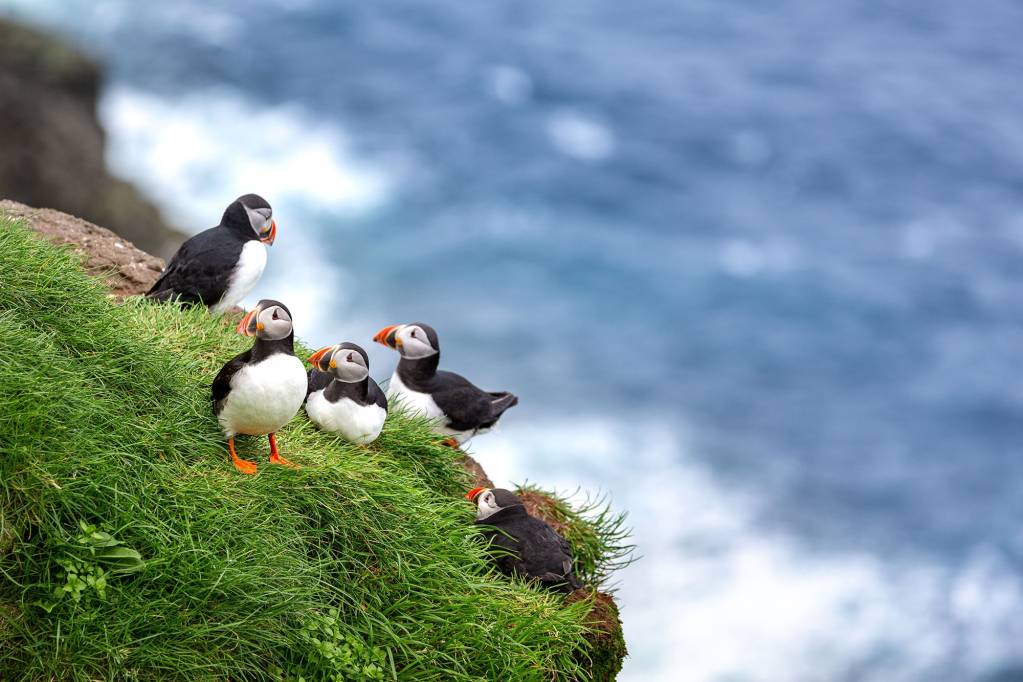The Faroe Islands are an archipelago comprising 18 rocky, mostly volcanic islands that lie between Iceland and Norway. While the islands are located directly north of Scotland, they are technically a part of the Kingdom of Denmark which laid claim to the islands following the Napoleonic Wars. Since 1949, the Faroe Islands have functioned as a self-governing entity within the Kingdom of Denmark.
Much of the islands are covered in a thin layer of peat soil that coats the volcanic bedrock. The islands are highly elevated and are marked by impressive cliffs, fjords, and narrow passages that form a gateway to the tides of the North Atlantic Ocean. The climate is impacted by the strong wind gusts that blow in from the ocean.

The westernmost island of the archipelago, Mykines, is especially popular with birders who long to observe the
various species of puffins, among other winged species. Photo: AdobeStock
For bird watchers, the Faroe Islands are a very appealing destination. The archipelago is home to a wide variety of bird species, and there are many popular birding sites scattered across the islands. The island of Mykines, the westernmost island in the archipelago, is especially noteworthy among bird watchers for its native bird species.
Where are the Faroe Islands?
The Faroe Islands are located over 650 kilometres off the coast of Northern Europe, situated between Iceland and Norway on the cusp of the Norwegian Sea. Their closest physical neighbor is the handful of islands off the northern coast of Scotland, which is approximately 600 km from the archipelago.
During the age of the Vikings, the Faroe Islands were discovered and adopted by the Kingdom of Norway. The islands later passed into the possession of Denmark before gaining their independence as a self-governing entity.
Due to their close proximity to Scotland, many explorers have claimed that the islands were actually discovered by British or Irish ancestors ahead of the Vikings. New evidence from historic remains found on the island have challenged this notion as scientists work to identify the background of the remains to help answer this long-debated question.
Best time to visit the Faroe Islands for bird-watching

Colonies of puffins occasionally share space with domesticated farm animals on Mykines, the westernmost
of the Faroe Islands. Photo: AdobeStock
If bird-watching is your pastime, you need to schedule your adventures based on when birds are most likely to appear in the wilds of the Faroe Islands. For that reason, the summer season is the best time to visit the Faroe Islands for bird-watching. The warmer months are when birds are most likely to appear, creating excellent opportunities for bird watchers to capture incredible pictures and videos of the animals in their most natural habitats.
Puffins are one of the most common birds you’ll see during an adventure to the Faroe Islands, but there are many more. Experts say that as many as one million birds migrate to the Faroe Islands during the summer months, which makes it the optimal time of year to photograph and document these animals in an amazing location.
Equipment needed for Faroe Islands bird watching
Since you’ll be visiting an island, it doesn’t hurt to bring waterproof photography equipment to ensure you can capture the best moments without concern. Flexible waterproof camera cases are excellent ways to protect your camera from the elements, and you can find cases specifically designed for both DSLR cameras as well as your standard smartphone.
Also, even though you’ll be traveling in the summer, the Faroe Islands are located near the Arctic Circle. With strong wind gusts blowing in from the ocean, you can expect cold temperatures to blow across the archipelago. This packing list guide will help you assemble all of the equipment you’ll need to stay warm during your adventure so that you can focus on capturing scenic moments of birds in paradise.
Tips for Faroe Islands bird-watching

The southern coast of Mykines Island is populated with thousands of puffins, especially in the
summer season. Photo: AdobeStock
As previously mentioned, Mykines is one of the best places to go for Faroe Islands bird watching. Thousands of puffins venture to the island in the summer season, and they’re particularly known to gather together along the southern coast of the island.
You’ll also come across northern fulmars, European storm petrels, black-legged kittiwakes, northern gannets, and guillemots on the journey. Your Quark Expeditions guide will help you stay abreast of what species to see and where as you venture across the islands.
Best way to visit the Faroe Islands for bird-watching
Now that you have an idea of what to expect on your trip to the Faroe Islands, what is the best way to visit the archipelago so you can immerse yourself in scenic bird-watching?
We recommend the Arctic Saga: Exploring Spitsbergen via the Faroes and Jan Mayen adventure. This is a 14-day expedition departing from Aberdeen, Scotland, and sailing as far north as the Svalbard archipelago in the Norwegian Sea.
You’ll reach the Faroe Islands on Day 4 of the journey and spend two days exploring the outer islands of the archipelago. Along the way, you’ll hike alongside breathtaking cliffs, ethereal landscapes, and beautiful fjords along the shoreline of the islands. Your expedition team will highlight the best locations to spot puffins and other birds that are native to the islands.
The second day of the adventure will also bring you to the capital of the archipelago, Tórshavn. One of the smallest capitals on the planet, Tórshavn has retained its Viking-Esque heritage. You’ll learn all about the Faroe Islands’ medieval history and see some of the historic landmarks that pay tribute to the medieval lineage that remains integral to the island culture.









